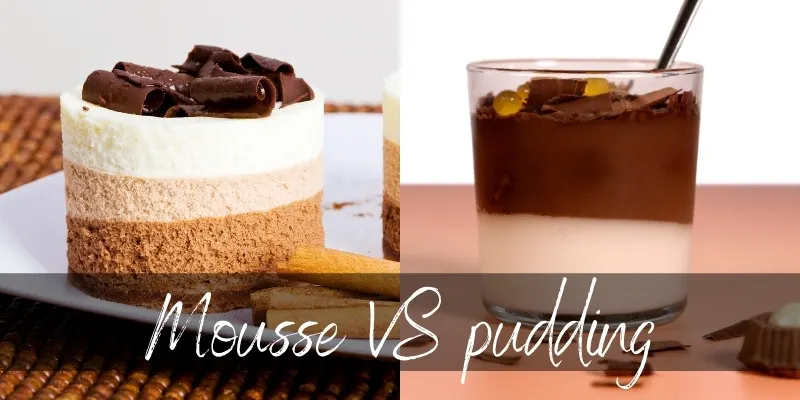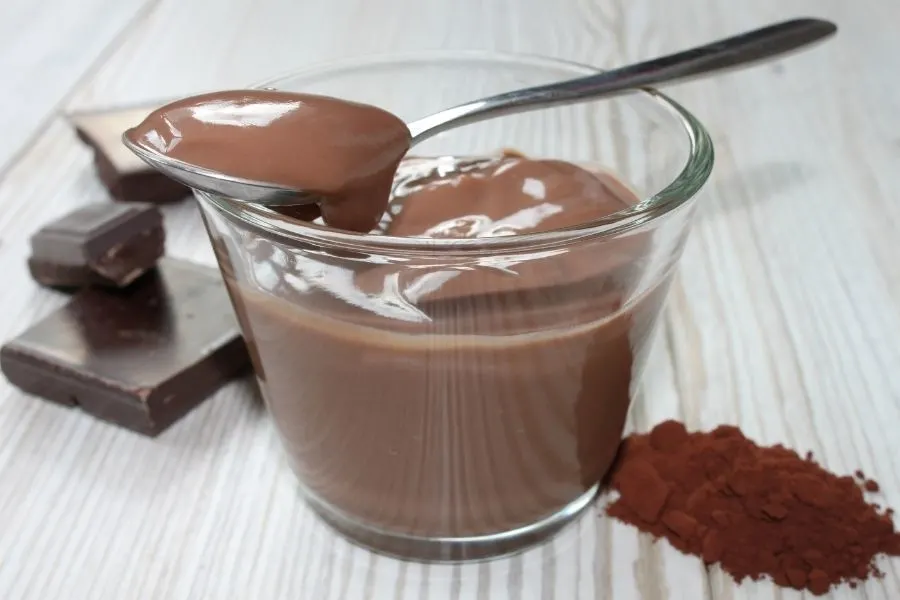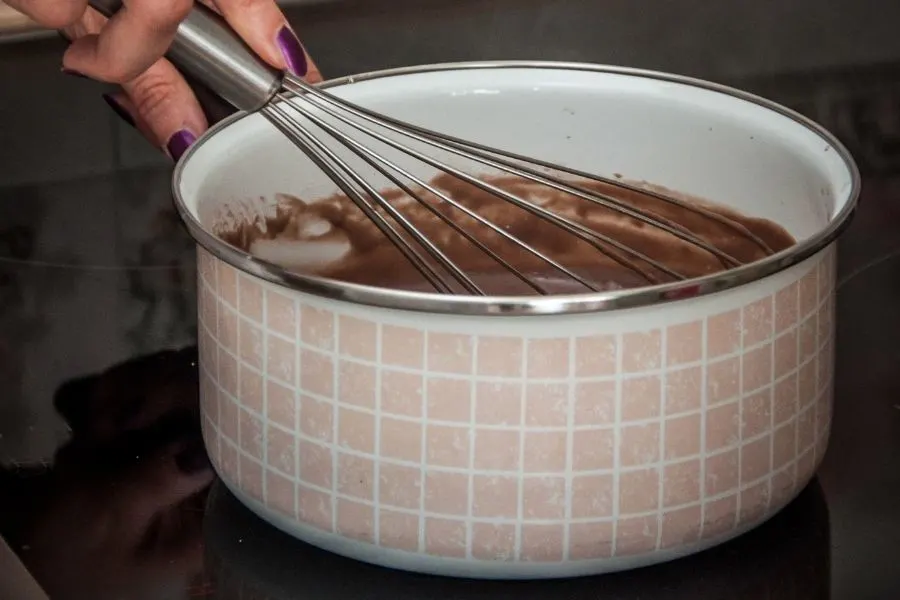If you’re staring down the dessert menu and can’t decide between mousse and pudding, we’re here to help. Not only are these two similar, the taste is also fairly similar.
And if you’re wondering which to make for dessert, knowing their key differences will let you know which would be a family favorite. Plus, if you ever have leftovers, one of these is very easy to turn into something else.

Mousse vs pudding
Mousse is an airy, fluffy yet thick froth while pudding is a dense cream that may or may not contain eggs, depending on the recipe. A key difference though is that pudding is always cooked, while mousse is not. At best, it’s tempered, but that’s not exactly cooking.
Because pudding is cooked, it can be served at any temperature from hot to completely cold. Mousse is always served cold or nearly frozen because it needs to set in the fridge for a while before serving.
And finally, it’s much easier to make an allergy-free pudding than it is to make a mousse, as mousse is supposed to contain eggs. Pudding can easily be made dairy and gluten-free, without sacrificing much in texture and flavor.
What is mousse ?
Mousse is a French word for foam or froth. This is because mousse is supposed to be light and airy, as it has those tiny air bubbles incorporated. For the most part, this happens due to whipped egg whites, but you will see some recipes adding cream (whipped or not) to further aid the airy texture.
Read also: Why Is Chocolate Ice Cream Harder To Scoop ?
Mousse may be savory or sweet, but most of the time it’s a sweet affair. The exact ingredients may vary according to the recipe, but it will almost always have some egg in it, at least egg whites to get fluffy.
What is pudding ?
Pudding is a thick cream usually made up of starch, sugar, flavoring, and milk. It differs from the old-timey puddings made with breadcrumbs and pectin from fruits, and is almost always sweet. Some recipes may add egg yolks to thicken and give a better flavor, some may add some heavy cream.

The way pudding works is that the cornstarch both thickens and sets the cream, leading to a very thick mouthfeel. When it’s put nicely in a serving bowl, pudding may look identical to mousse. But they’re very different, and we’ll explore those differences in the rest of this post.
1. Pudding is thickened with cornstarch
One of the key differences between pudding and mousse is the presence of cornstarch. They have many ingredients that overlap, and the line seems blurred sometimes, but one thing is always constant. Mousse is never going to have cornstarch to get thick.
For one, cornstarch needs to be cooked and you don’t cook mousse. And second, cornstarch adds a different kind of thickness, definitely not what mousse should be.
Mousse is supposed to be light and airy, thickening it with cornstarch would defeat that. It would also be harder for the millions of air bubbles to sustain all that weight.
2. Mousse is light and airy, contains eggs
Because mousse is made with eggs, it’s light and airy. Skipping the eggs is possible, but you will get a result that’s less fluffy or impressive. A key mechanism is beating the egg whites and mixing them with the rest of the ingredients that are already turned into a cream.
You may also find egg yolk in mousse, to add richness and boost flavor. If you were to remove the eggs altogether, you’d still need something to get it fluffy. So you’d need to whip some cream, or some aquafaba to get it to keep its bubbles.
Pudding, on the other hand can be made completely egg-free, although it does end up tasting better if you do add eggs. Please note that instant pudding mixes don’t need eggs to thicken, they rely on cornstarch. But if you want to make a pudding from scratch, you need a whole lot of egg yolks, some cornstarch or flour, and a lot of patience and constant stirring.
Puddings made with eggs needs extra love and care, because the eggs can easily scramble. And if you want to thicken using only eggs, boy, do you need an entire chicken farm. You’ll end up adding some cornstarch halfway through, we promise.
3. Pudding is cooked through, mousse is not
As pudding has cornstarch, it needs some cooking for at least a couple of minutes to thicken and cook through. This activates the rest of the flavors, and you get a nice, cohesive final product.

Mousse is not cooked, at best, the egg whites are tempered with some hot sugar syrup and you end up with Italian meringue. It’s a very stable, smooth whipped egg white that’s also cooked through without tasting like an omelette. Some are just French meringue, which is not tempered. It really depends on the recipe.
4. Mousse is always served cold, pudding may be warm
Because of the way they’re made, these two desserts are served differently. Mousse is not cooked through, and often uses French meringue. This means it needs to set in the fridge for a few hours, so you need to serve it cold or nearly frozen.
Pudding can be served hot, warm, room temp, or even completely cold. It keeps better if you let it sit in the fridge, and this way you can even pipe some whipped cream on top.
5. Pudding can be turned into cake filling
In case you find yourself with leftover pudding, you can always turn it into a cake filling. You need warm butter or margarine, and a pudding that’s not too thick. Cut the butter into small cubes, make sure they’re softened. Mix with a mixer, it may look weird at first. As long as you mix it enough and the butter is soft and room temp, it should mix right in.
This cake filling does resemble buttercream, but as you can see, there’s something extra, and it will make for a very thick, creamy filling.
Mousse cannot be used as a filling, because it needs all those air bubbles. if you were to sandwich it between two cake layers, it’d lose a lot of air and deflate. At best, you could try and use it as a decoration on top, or as a crumb coat.
Both are creamy desserts that are easily confused
When looking at the dessert fridge in an establishment, you may be wondering which is which. Well, unless you can get up close and personal, there’s no telling them apart. Both usually have some whipped cream or fruit or some form of topping.
And both are served in the same kind of dish. Both are dense but mousse may show a few bubbles on the sides if you look hard enough. Most of the time you’ll only notice this when you take a spoonful and look inside.
Read Also: Can You Make Pudding With Water Instead Of Milk ?
What about custard ?
Well of mousse has eggs but no cornstarch, and pudding has cornstarch and maybe sometimes eggs, what about custard ? Well, custard is a very blurred line, but most of the time you’ll notice it’s significantly thinner than a pudding.
It can be thicker, and you can also make pudding thinner so then you can’t easily tell them apart. But in short custard doesn’t usually have cornstarch, and instead relies on egg yolk and cream cooking together and thickening.
In the end though, do all of these distinctions really matter ? As long as your dessert comes outright, it doesn’t matter if it’s a custard, pudding, or mousse. It could be anything you want it to be.

